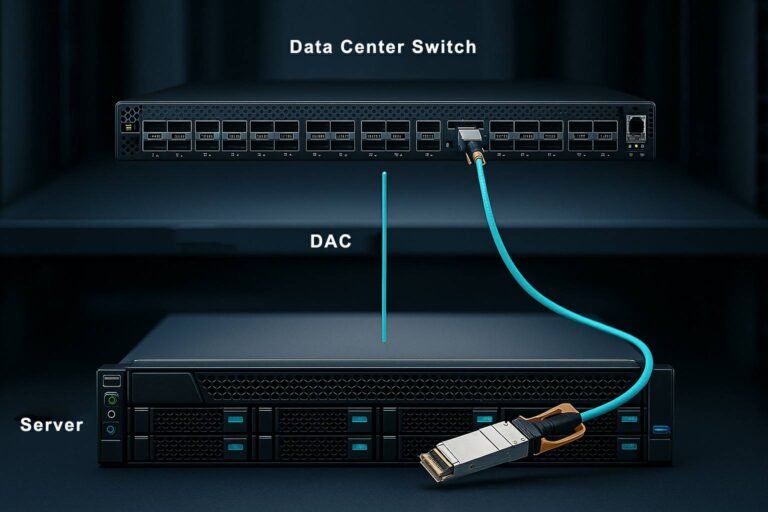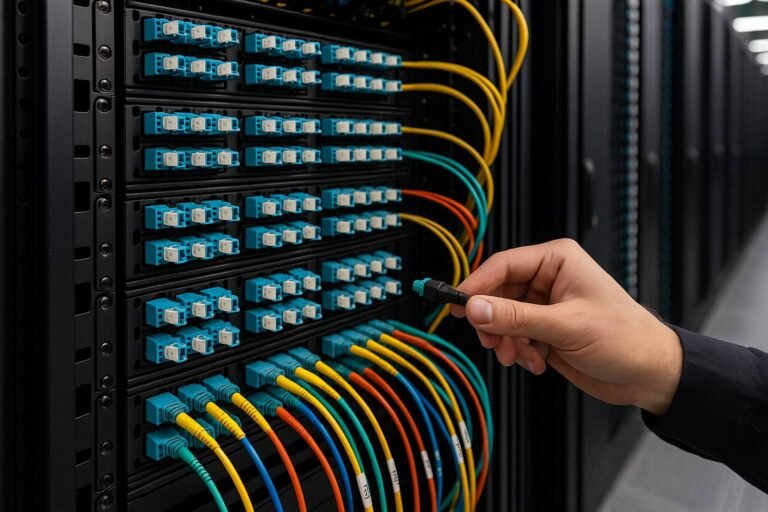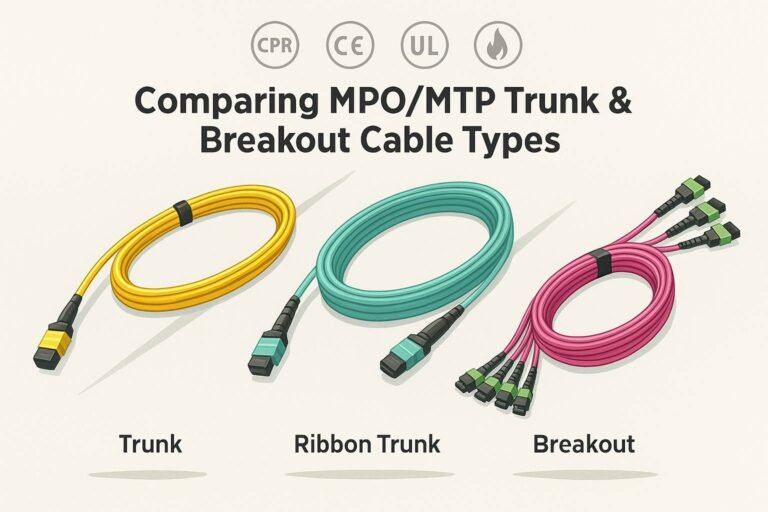What Are the Specifications and Standards for OPGW Cables?
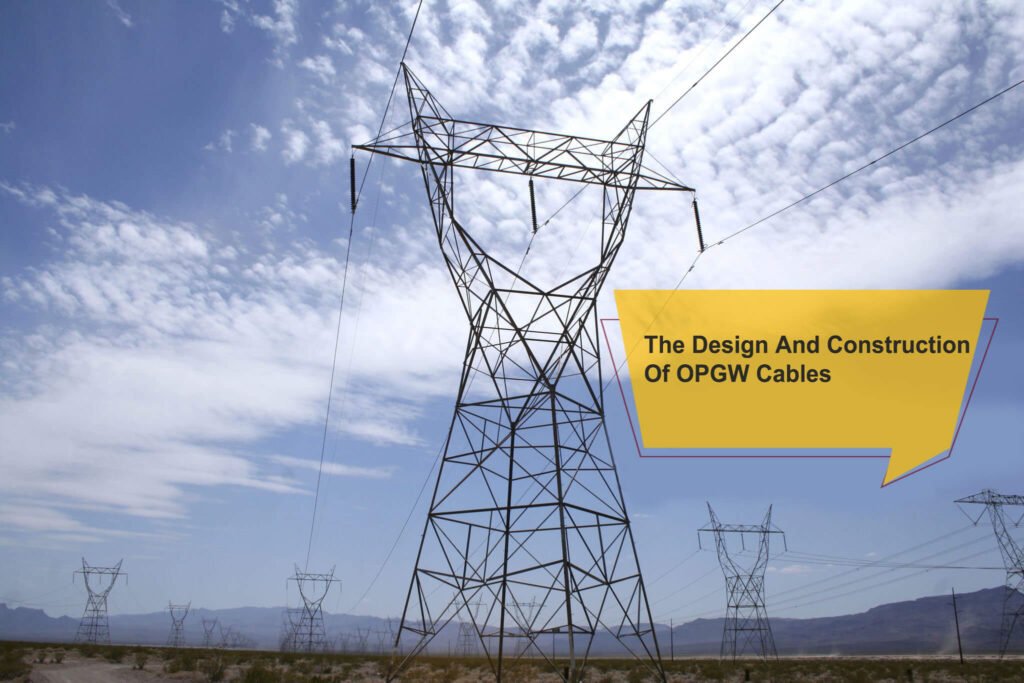
I am Anya, and I work at ABPTEL in Shenzhen, China. I have spent many years focusing on optical fiber solutions, including OPGW (Optical Ground Wire) cables. Today, I want to share how my team and I view OPGW cable specifications and standards. We aim to support telecom engineers, project managers, and product specialists who want to ensure robust and efficient infrastructure.
In the ever-evolving world of telecommunications, ensuring a reliable network is critical. I have seen networks fail during unexpected storms or heavy power loads, and I know how frustrating that can be. Over time, I learned that a major key to building reliable networks is understanding the technical details of every component. OPGW cables are especially important because they combine a ground wire function with fiber optic data capabilities. If these cables fail, data transmissions and electrical protection can both be compromised.
I recall one instance in a large project in South America. They had chosen an OPGW cable that did not fully meet local regulatory requirements. They thought they would save time by installing what was already in stock. They ended up replacing everything months later, incurring extra costs and weeks of downtime. That experience taught me the value of paying close attention to recognized standards and specifications from day one.
Below, I will share what I have learned about OPGW cables, focusing on how they comply with important global benchmarks. If you work on data center expansions, FTTA (Fiber to the Antenna) rollouts, or large-scale telecom upgrades, these insights can help you choose cables that last and meet all relevant guidelines.
OPGW cables are specialized cables that combine the functions of a ground wire for electrical protection and a fiber optic cable for data transmission. They adhere to international1 and local standards2 to ensure safety, functionality, and durability, making them essential for modern telecommunications infrastructure.
I have seen telecom operators who only focused on the data side, forgetting that OPGW cables also must meet specific electrical grounding requirements. That can be an expensive oversight. These cables carry critical data on the fiber side, but they also protect the high-voltage lines by functioning as a ground. Proper compliance with recognized standards is vital.
Imagine a world where your telecommunications network is both secure and highly efficient. With OPGW cables, this vision becomes a reality. These cables play a crucial role in today’s data-driven society, ensuring seamless data transmission and robust electrical protection. Read on to discover the detailed specifications and standards that make OPGW cables indispensable.
What Are the General Requirements for OPGW Cables?
Optical Ground Wire (OPGW) cables must comply with a range of international and local standards to perform effectively in their dual roles. These standards, including IEEE 1138-20093, IEC 60793-14, IEC 60793-25, and IEC 60794-1-16, ensure that the cables meet necessary safety and performance benchmarks.
I recall a project in Africa where local regulations closely followed IEEE standards. The utility insisted on verifying test reports for tension, short-circuit capacity, and fiber attenuation. Our cables met or exceeded the benchmarks. That gave the utility confidence to finalize the deal. In that moment, I realized how compliance reduces risk for both buyers and suppliers.
Compliance with these standards guarantees that OPGW cables can withstand environmental stresses while providing reliable electrical protection and data transmission. This compliance is crucial for maintaining the integrity and functionality of telecommunications networks.
Understanding these requirements helps telecom engineers and product managers ensure that their infrastructure meets global benchmarks. In turn, they can reduce the risk of failures and enhance overall network performance. Compliance with these standards is not just a formality; it’s a foundational element of effective telecom infrastructure.
Why Compliance Matters
- Regulatory Acceptance: Local power utilities or data center operators often require proof that OPGW cables meet international norms.
- Long-Term Reliability: A cable that meets IEEE or IEC standards is more likely to last under harsh conditions.
- Safety Assurance: OPGW cables that pass recognized tests reduce the risk of short circuits or grounding failures.
Common Pitfalls in Overlooking Standards
- Unexpected Rework: Installing cables that fail local inspections leads to do-overs.
- Insurance Limitations: Some insurers only cover networks built with standards-compliant components.
- Performance Gaps: Cables that do not meet tension or short-circuit benchmarks risk breaking under stress.
How Is the Design and Construction of OPGW Cables Achieved?
OPGW cables are constructed with precision, incorporating several critical components to fulfill their dual functions. They typically contain multiple optical fibers, ranging from 24 to 48 or more, which can be either single-mode or dual-window single-mode (DWSM) fibers7. These fibers adhere to standards such as ITU-T G.6528 and G.652D.
I remember one advanced data center project in North America where the client insisted on G.652D fibers to future-proof their data capacity. They believed it would handle higher data rates over long distances with minimal attenuation. Indeed, G.652D is widely accepted for high-speed networks.
The design of OPGW cables includes a central tube made of materials like aluminum or stainless steel, filled with water-blocking gel for environmental protection. Surrounding this tube are layers of conductor strands that provide mechanical strength and conductivity.
Optical Fibers
Optical fibers are at the heart of OPGW cables, allowing for efficient data transmission. Each fiber must meet stringent standards to ensure high performance and durability. I have tested fiber from different manufacturers in our lab at ABPTEL. Some low-quality fibers degrade quickly under temperature cycles, which can cause high insertion loss. Adhering to ITU-T and IEC guidelines can minimize that risk.
Central Tube Construction
The central tube, often crafted from robust materials, houses the optical fibers and shields them from environmental harm. The water-blocking gel9 is essential for preventing moisture ingress, which can degrade performance. I once saw a cable installed in a humid coastal region. Without proper water-blocking features, salt and humidity caused microbends in the fibers. Performance dropped significantly in just a few months.
Outer Layers
The outer layers are vital for the mechanical integrity of the cable. By employing materials like aluminum and steel, these layers offer the necessary strength and conductivity required for effective operation.
Key Elements in OPGW Construction
- Strength Members: Typically steel or aluminum-clad steel, to bear mechanical loads.
- Conductor Strands: Provide path to ground, plus additional protection to the cable core.
- Anti-Corrosion Coatings: Resist rust in harsh climates.
Table: Example of OPGW Construction Layers
| Layer | Material | Role in Cable |
|---|---|---|
| Outer Strands | Aluminum or Al-clad Steel | Conductive path to ground, mechanical shield |
| Central Tube | Stainless Steel or Aluminum | Houses fibers, protects them from environment |
| Water-Blocking Gel | Hydrophobic Gel | Prevents moisture intrusion |
| Optical Fibers | G.652 / G.652D Single-Mode | High-speed data transmission |
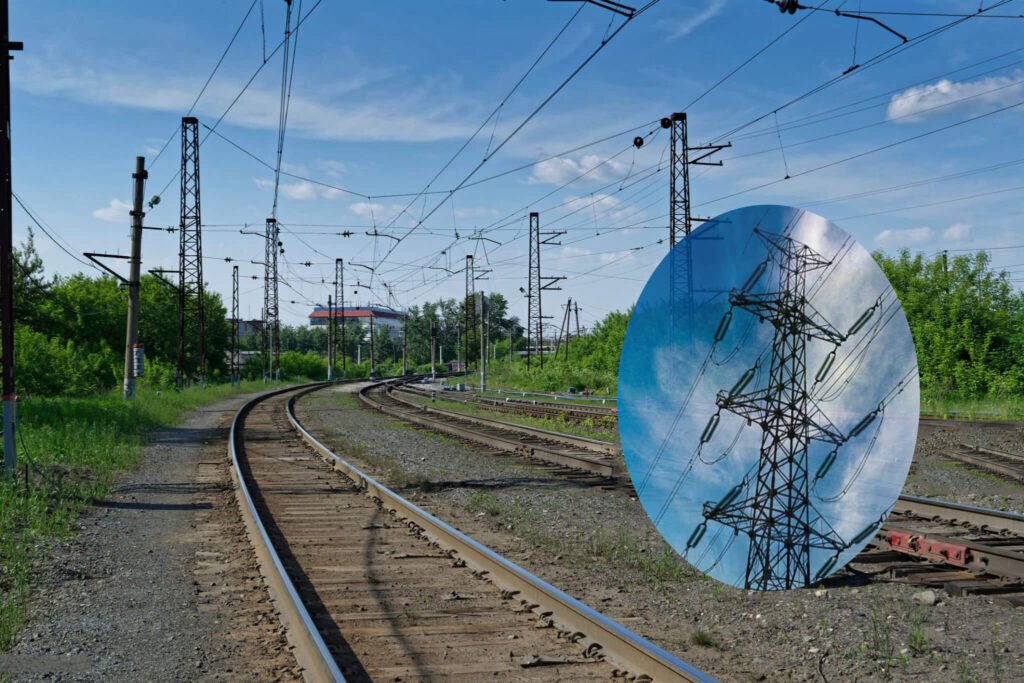
What Are the Mechanical and Electrical Properties of OPGW Cables?
The mechanical and electrical properties of OPGW cables are carefully defined to ensure their performance in diverse conditions. The overall diameter is typically limited, with a maximum nominal overall diameter of 14.5 mm and a mass of less than 0.420 kg/m.
In my experience, a client might ask: "Will this cable handle the tension of our overhead lines in windy areas?" The mechanical properties directly address this concern. We test the cable’s rated tensile strength (RTS) and how it behaves under short-circuit currents.
OPGW cables must have a minimum breaking load ranging from 49 kN to over 100 kN, along with specific short circuit capacity and DC resistance limits.These properties are crucial for maintaining cable integrity and functionality.
Understanding RTS and Short-Circuit Capacity
- Rated Tensile Strength (RTS): This is the maximum tension the cable can handle without permanent damage. If your region has strong winds or heavy ice loads, pick a cable with a higher RTS.
- Short-Circuit Capacity: OPGW acts as a ground wire. During a fault, it may conduct large currents. The cable must handle that without melting or warping.
- DC Resistance: Lower DC resistance generally means better conductivity. That helps in better grounding performance.
Field Example
I managed a project in Northern China with harsh winters and frequent icing. We needed a cable with a high breaking load, over 80 kN, so it could handle ice accumulation on lines. We compared different cable specs, checked short-circuit calculations, and found one that matched the needed margin of safety.
Table: Typical Mechanical Properties
| Property | Typical Range | Significance |
|---|---|---|
| Nominal Diameter | Up to ~14.5 mm | Fits on standard sheaves & tower attachments |
| Mass per Unit Length | < 0.420 kg/m | Affects tower load calculations |
| Minimum Breaking Load | ~49 kN to 100+ kN | Indicates tension capacity |
| Short-Circuit Capacity | Varies (kA^2s rating) | Ensures durability during fault currents |
| DC Resistance | Typically < 1.0 Ω/km | Improves grounding efficiency |
What Are the Environmental and Operational Requirements for OPGW Cables?
OPGW cables are designed to operate within specific environmental ranges to ensure reliability. They must function within temperature ranges like -40°C to +70°C and have an installation temperature range of -25°C to +60°C.
When I was involved in an overseas project in the Middle East, I saw daily temperatures exceed 50°C. We needed cables that could handle that. Also, nighttime temperatures can drop unexpectedly in deserts. OPGW cables are tested to ensure they maintain operational integrity in these swings.
These cables must maintain operational integrity in diverse climates, with a minimum bending radius around 450 mm to prevent damage during installation.Such specifications ensure that OPGW cables can be deployed in a variety of settings without compromising performance.
Environmental Challenges
- Extreme Temperature Variations: Some regions range from scorching days to freezing nights. The metal and fiber must expand or contract without damage.
- Ice or Snow Load: In cold regions, ice buildup can add significant weight. The cable must handle that extra load.
- High Humidity: Coastal or tropical areas bring moisture that can corrode metal or seep into poorly sealed cables. Water-blocking gel and robust sealing are essential.
Installing in Challenging Terrains
- Mountainous Regions: Sharp elevation changes demand cables with strong mechanical properties.
- Urban Environments: Sometimes, city regulations require smaller cable diameters or certain fire-retardant jackets.
- Swampy / Flood-Prone Areas: If towers or poles sit in marshy ground, the cable must handle constant moisture.
Table: Typical Environmental Specifications
| Specification | Typical Range | Reason for Importance |
|---|---|---|
| Operating Temperature | -40°C to +70°C | Ensures performance under extreme climates |
| Installation Temperature | -25°C to +60°C | Avoids cable damage during deployment |
| Bending Radius | ~450 mm minimum | Prevents fiber stress or bending loss |
| UV Resistance | Must pass UV tests | Cables are exposed to sunlight if overhead |
| Water Ingress Protection | Water-blocking gel | Stops moisture from harming fiber cores |
Why Is Testing and Compliance Crucial for OPGW Cables?
All components of OPGW cables undergo rigorous testing to ensure compliance with relevant standards. This includes mechanical, electrical, and optical performance tests according to Australian10 and international standards11.
Testing and compliance ensure that OPGW cables meet all necessary performance criteria, providing peace of mind and reliability to telecom networks. Such diligence is essential for maintaining high standards of quality and functionality.
Testing Procedures
At ABPTEL, we regularly run cables through a series of tests in our lab. For mechanical tests, we use tension rigs to measure breaking loads. For optical tests, we do OTDR (Optical Time Domain Reflectometer) sweeps to confirm attenuation. We also simulate temperature cycles in environmental chambers to see if the fiber experiences microbending or any structural damage. Then we document everything.
Common OPGW Tests
- Tensile Test: Determines if the cable meets or exceeds the rated tensile strength.
- Short-Circuit Test: Simulates a fault current going through the cable for a set duration.
- Thermal Cycling: Repeatedly exposes the cable to hot and cold extremes to check for fiber or jacket degradation.
- Vibration or Aeolian Vibration Test: Checks if the cable can handle wind-induced vibrations without fatigue.
- Optical Attenuation Test: Uses light sources at 1310 nm and 1550 nm to measure signal loss.
Table: Example of Compliance Tests and Their Purposes
| Test Name | Purpose | Standards Referenced |
|---|---|---|
| Tensile / Tension Test | Checks cable's mechanical endurance | IEEE 1138, IEC 60794-1-1 |
| Short-Circuit Test | Validates cable's fault current capability | IEEE 1138 |
| Thermal Cycling | Ensures material stability in temperature swings | IEC 60793-1, IEC 60794-1-1 |
| Vibration / Aeolian Test | Confirms cable durability under wind vibration | IEEE 1138, local guidelines |
| OTDR Attenuation Test | Measures optical performance | IEC 60793-2, ITU-T G.652 |
For telecom engineers and product managers, understanding the importance of testing and compliance helps ensure that their networks are both safe and effective, minimizing risks and optimizing performance. I once worked with a client who skipped detailed testing for a small rural project. They faced unexpected mechanical failures a year later, ironically costing more money than if they'd done upfront testing.
Conclusion
In summary, OPGW cables are a critical component of modern telecommunications infrastructure, offering both electrical protection and data transmission capabilities. By adhering to stringent specifications and standards, these cables ensure reliability and performance across diverse conditions. Understanding these elements is crucial for telecom engineers and product managers aiming to enhance their network’s efficiency and resilience. By selecting the right OPGW cables and ensuring compliance with global standards, professionals can confidently build robust and efficient telecommunications systems that stand the test of time.
I have witnessed how these technical details can be the difference between a stable network and one prone to outages. At ABPTEL, we take compliance seriously. We examine cable designs, run tests, and confirm certifications before we ship to clients. It takes time, but it protects everyone’s investment. When your cables must handle both data and grounding functions, the cost of a failure can be huge. That is why I always recommend verifying references, compliance documents, and real-world test results.
As you move forward with your OPGW projects—whether it is for a data center, a power utility, or a telecom tower—remember that the best results come from aligning your choices with established specifications and recognized standards. Doing so not only fosters a stable network but also reduces future operational risks. I hope this overview has helped you understand why OPGW cables are indispensable and how to ensure they meet the performance levels you need.
| Query for Google | Explanation |
|---|---|
Optical Ground Wire OPGW cables |
Provides a comprehensive understanding of OPGW cables, which are crucial for both data and power lines. |
OPGW cables international standards |
Explains the international standards OPGW cables must adhere to, ensuring global functionality and safety. |
Local standards for OPGW cables |
Details standards specific to certain regions, vital for localized compliance and safety assurance. |
IEEE 1138-2009 standard |
Describes the IEEE standard recognizing OPGW cables' dual functions, ensuring electrical and data fidelity. |
IEC 60793-1 fiber standards |
Offers details about the IEC standards for fiber optics, ensuring quality and performance in OPGW cables. |
IEC 60793-2 cable specifications |
Provides specifics on fiber optic cables, enhancing understanding of optical performance benchmarks. |
IEC 60794-1-1 cable tests |
Explains test protocols ensuring cable durability and data transmission quality in complex setups. |
Single-mode and DWSM fiber optics |
Differentiates between fiber types used in OPGW, critical for informed selections in network designs. |
ITU-T G.652 fiber specification |
Details the standard for single-mode fibers, key for setting performance benchmarks in telecom networks. |
Water-blocking gel in cables |
Discusses the use of gel in cables to prevent moisture, crucial for longevity and reliability of OPGW. |
Australian standards for telecommunications |
Provides context on the national guidelines ensuring telecom safety and efficacy within Australia. |
International testing standards for OPGW |
Offers a look into international protocols for ensuring OPGW cables meet necessary global standards. |
-
Explains the international standards OPGW cables must adhere to, ensuring global functionality and safety. ↩
-
Details standards specific to certain regions, vital for localized compliance and safety assurance. ↩
-
Describes the IEEE standard recognizing OPGW cables' dual functions, ensuring electrical and data fidelity. ↩
-
Offers details about the IEC standards for fiber optics, ensuring quality and performance in OPGW cables. ↩
-
Provides specifics on fiber optic cables, enhancing understanding of optical performance benchmarks. ↩
-
Explains test protocols ensuring cable durability and data transmission quality in complex setups. ↩
-
Differentiates between fiber types used in OPGW, critical for informed selections in network designs. ↩
-
Details the standard for single-mode fibers, key for setting performance benchmarks in telecom networks. ↩
-
Discusses the use of gel in cables to prevent moisture, crucial for longevity and reliability of OPGW. ↩
-
Provides context on the national guidelines ensuring telecom safety and efficacy within Australia. ↩
-
Offers a look into international protocols for ensuring OPGW cables meet necessary global standards. ↩

